EMeRGe
Effect of
Megacities on the Transport and Transformation of Pollutants on the
Regional to Global Scales
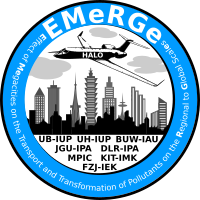
News
TEAM-5 Workshop in June 2021
Posted on 15 July 2021 by Wilke
A zoom EMeRGe Workshop z-TEAM-5 took place on the 17.06.2021 with the participation of about 30 members of the EMeRGe International community
in Europe and Asia. Short presentations motivated the exchange of ideas and the discussion, which focused on the interpretation of the Asian
data sets, the comparison of the EMeRGe results in Europe and Asia and the implementation of different modelling strategies.
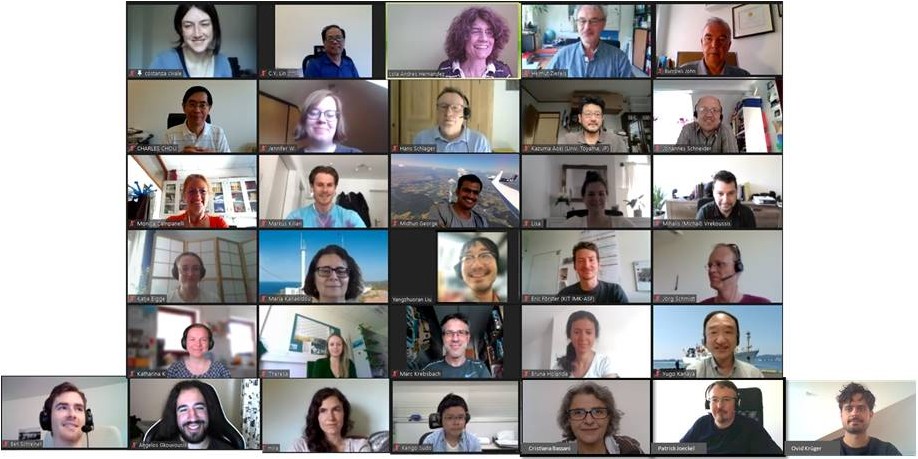
→ TEAM-5 workshop: agenda etc.

→ TEAM-5 workshop: agenda etc.
ACP/AMT special issue on EMeRGe data
Posted on 28 May 2020 by Wilke
The ACP/AMT special issue on EMeRGe data has opened and the first paper is now published.
A preprint is under review and we expect others coming soon. You can follow it at:
https://www.atmos-meas-tech.net/special_issue10_1074.html
https://www.atmos-meas-tech.net/special_issue10_1074.html
Andreas Hilboll passed away on 25. March 2020 in a hospital in Crete as the result of COVID-19
Posted on 31 Mar 2020 by Wilke
Dear all,
We would like to sincerely thank you all for your support and the condolences received after the devastating news on the tragic loss of Andreas Hilboll. To honor the memory of our wonderful friend and colleague, we created a dedicated website [thanks to the tremendous support from Marius Dan]. You can find the link of the site below:
https://www.iup.uni-bremen.de/lamos/Andreas-Hilboll.html
Please access this site and leave a comment if you wish to do so. Please note that your messages will be uploaded daily. If you would like to share a photo you took with Andreas, please send it directly to:
lamos_it@groups.uni-bremen.de
With Kind Regards,
Mihalis Vrekoussis, John Burrows and Maria Kanakidou
We would like to sincerely thank you all for your support and the condolences received after the devastating news on the tragic loss of Andreas Hilboll. To honor the memory of our wonderful friend and colleague, we created a dedicated website [thanks to the tremendous support from Marius Dan]. You can find the link of the site below:
https://www.iup.uni-bremen.de/lamos/Andreas-Hilboll.html
Please access this site and leave a comment if you wish to do so. Please note that your messages will be uploaded daily. If you would like to share a photo you took with Andreas, please send it directly to:
lamos_it@groups.uni-bremen.de
With Kind Regards,
Mihalis Vrekoussis, John Burrows and Maria Kanakidou
EGU 2020 session on impacts of major population centres on tropospheric chemistry and composition
Posted on 11 Dec 2019 by Wilke
The EGU General Assembly 2020 takes place in Vienna, Austria, from 3. - 8. May 2020.
The session AS3.23 focus on the impacts of emissions from major population centres on tropospheric chemistry and composition.
The abstract submission deadline is Wednesday, 15th of January 2020 (13:00 CET).
More information on the session and instructions for the submission of abstracts can be found here:
https://meetingorganizer.copernicus.org/EGU2020/session/36877
Session AS3.23: Impacts of emissions from major population centres on tropospheric chemistry and composition.
The number and size of urban conurbations, which comprise megacities and different urban agglomerations, collectively known as major population centres (MPC), has increased dramatically. By 2050, the population is predicted to rise to ~10 billion with about 75% being urban dwellers. MPCs require power, mostly generated from fossil fuel combustion for their transport systems, industry and domestic heating, cooling etc. MPCs are globally a growing and significant source of emissions of trace gases and aerosols into the troposphere. The air quality in the MPC and the transformation of the emitted pollutants is also often influenced by the transport of biomass burning and pollution plumes. Because of the variability of the naturally occurring emissions of trace constituents, the different characteristics of MPC, the mixing and interaction of the outflow from MPC with those from the surrounding areas, and the need to account for the local topography and meteorology, the assessment and prediction of the impact of pollution from MPC on tropospheric chemistry is challenging. The current knowledge of the effect of this anthropogenic pollution on the air quality and the regional tropospheric chemical composition, and its interaction with climate in a warming world is inadequate.
The trace constituent of interest from MPC emissions are short-lived climate pollutants, their precursors, and long lived greenhouse gases. To assess and better understand the local and regional impact of these pollutants, experimental and modelling investigations of the transformation of MPC emissions during their transport are required. This necessitates the consistent interpretation of observational data sets, having different spatial and temporal resolutions, generated from ground-based networks, airborne campaigns and satellite measurements. This further requires a hierarchy of model studies.
The purpose of this session is to present and discuss results from recent national and international projects studying the emissions from megacities and MPC and their transport and transformation. The session welcomes presentations about relevant observations, data interpretation and modelling studies. One focus is on the studies of MPC emissions from different continents, experiencing different meteorological conditions and the resultant local and regional impacts.
Convener: Maria Dolores Andrés Hernández | Co-conveners: Matthias Beekmann, Charles C.–K. Chou, Helmut Ziereis
The session AS3.23 focus on the impacts of emissions from major population centres on tropospheric chemistry and composition.
The abstract submission deadline is Wednesday, 15th of January 2020 (13:00 CET).
More information on the session and instructions for the submission of abstracts can be found here:
https://meetingorganizer.copernicus.org/
Session AS3.23: Impacts of emissions from major population centres on tropospheric chemistry and composition.
The number and size of urban conurbations, which comprise megacities and different urban agglomerations, collectively known as major population centres (MPC), has increased dramatically. By 2050, the population is predicted to rise to ~10 billion with about 75% being urban dwellers. MPCs require power, mostly generated from fossil fuel combustion for their transport systems, industry and domestic heating, cooling etc. MPCs are globally a growing and significant source of emissions of trace gases and aerosols into the troposphere. The air quality in the MPC and the transformation of the emitted pollutants is also often influenced by the transport of biomass burning and pollution plumes. Because of the variability of the naturally occurring emissions of trace constituents, the different characteristics of MPC, the mixing and interaction of the outflow from MPC with those from the surrounding areas, and the need to account for the local topography and meteorology, the assessment and prediction of the impact of pollution from MPC on tropospheric chemistry is challenging. The current knowledge of the effect of this anthropogenic pollution on the air quality and the regional tropospheric chemical composition, and its interaction with climate in a warming world is inadequate.
The trace constituent of interest from MPC emissions are short-lived climate pollutants, their precursors, and long lived greenhouse gases. To assess and better understand the local and regional impact of these pollutants, experimental and modelling investigations of the transformation of MPC emissions during their transport are required. This necessitates the consistent interpretation of observational data sets, having different spatial and temporal resolutions, generated from ground-based networks, airborne campaigns and satellite measurements. This further requires a hierarchy of model studies.
The purpose of this session is to present and discuss results from recent national and international projects studying the emissions from megacities and MPC and their transport and transformation. The session welcomes presentations about relevant observations, data interpretation and modelling studies. One focus is on the studies of MPC emissions from different continents, experiencing different meteorological conditions and the resultant local and regional impacts.
Convener: Maria Dolores Andrés Hernández | Co-conveners: Matthias Beekmann, Charles C.–K. Chou, Helmut Ziereis
TEAM-4 Workshop in December 2019
Posted on 30 Sep 2019 by Wilke
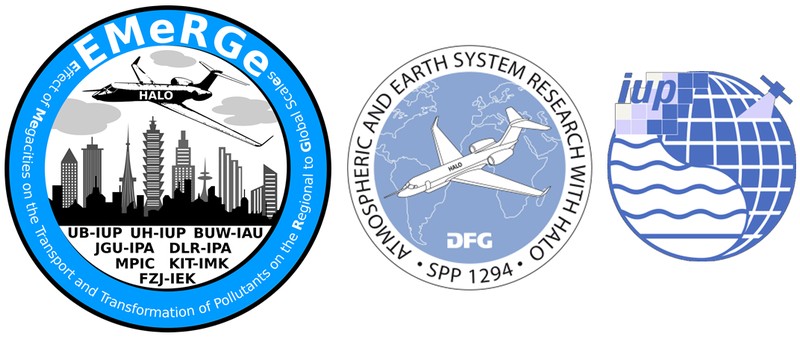
The next topical workshop "Transport and transformation of pollutants from European and Asian Major population centres - overall results from HALO-EMeRGe campaigns (TEAM-4)” will be organised and hosted by the Institute of Environmental Physics at the University of Bremen on the 17th - 19th December 2019.
The meeting will mainly focus on the presentation and discussion of EMeRGe data obtained within the European and Asian campaigns. Apart from this, progress on existing and proposed collaborations exploiting the data of EMeRGe will be reported.
→ TEAM-4 workshop: registration form etc.
EMeRGe contribution to the IUGG in Montreal
Posted on 22 Jul 2019 by Wilke
EMeRGe was well represented at the 27th Assembly of the International Union of Geodesy and Geophysics (IUGG)
taking place in Montreal from the 8th to the 18th July 2019. Part of the team reported about the project and
presented updated analysis and interpretation of the results of both EMeRGe campaigns in the IAMAS session “Air Quality in the Changing Antropocene”.
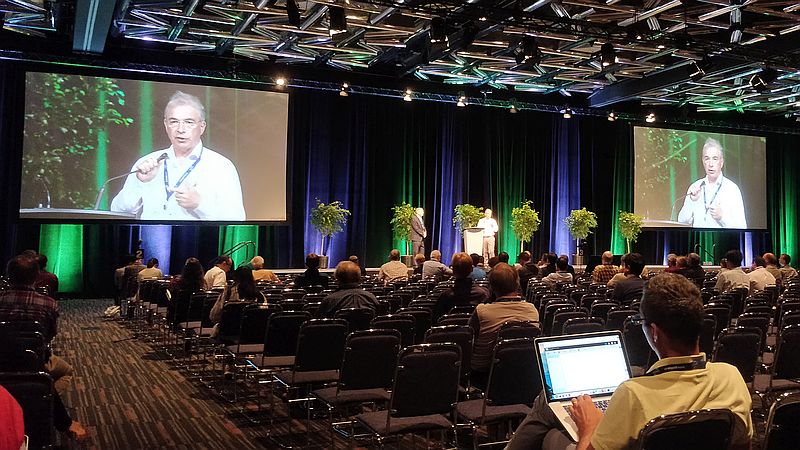
Prof. John P. Burrows speaking at the IUGG

Prof. John P. Burrows speaking at the IUGG
The Burgos station has been recognized as a "full" TCCON station after two years of successful operation and the validation within EMeRGe in Asia
Posted on 06 Jun 2019 by Wilke
The Total Carbon Column Observing Network (TCCON) is a network dedicated to the precise remote sensing measurement of column-averaged dry-air mole fractions (DMF) of CO2, CO, CH4, N2O and H2O.
Column-averaged DMF of gases (denoted as XG for gas G, e.g. XCO2) can be used in combination with in situ measurements to disentangle the effects of atmospheric mixing and surface exchange of
atmospheric gases, providing a better understanding of the regional-scale fluxes.
The accuracy of TCCON data products leans on the knowledge of spectroscopic parameters of target and potential interfering trace gases, and of radiative transfer. The validation of TCCON generally relies on aircrafts and balloons that measure vertical profiles of XG, such as XCO2, reaching high altitudes, with instrumentation adhering to recognized standards.
After two years of successful operation, the Burgos station (https://tccon-wiki.caltech.edu/Sites/Burgos) has been recognized as a “full” TCCON station by the TCCON steering committee at the annual meeting held in Wanaka, New Zealand. Within the EMeRGe campaign in Asia, profiles of CO2 and CH4 measured on board of the "High Altitude and Long Range Research Aircraft" (HALO: https://www.halo.dlr.de) were provided the Burgos TCCON station in order to fulfil this requirement.
This is a significant contribution to TCCON and to the validation of space-based greenhouse gases remote sensing satellites like GOSAT, GOSAT-2, OCO-2, TROPOMI, etc. and to science in Southeast Asia.
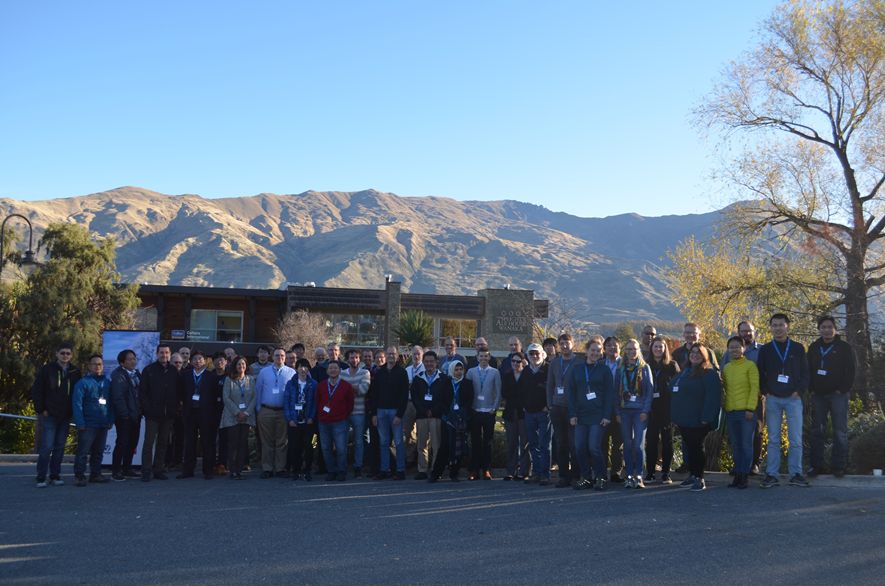 Members of the TCCON and NDACC networks at the annual meeting held in Wanaka, New Zealand.
Members of the TCCON and NDACC networks at the annual meeting held in Wanaka, New Zealand.
https://sites.google.com/view/irwgtccon19/home
The accuracy of TCCON data products leans on the knowledge of spectroscopic parameters of target and potential interfering trace gases, and of radiative transfer. The validation of TCCON generally relies on aircrafts and balloons that measure vertical profiles of XG, such as XCO2, reaching high altitudes, with instrumentation adhering to recognized standards.
After two years of successful operation, the Burgos station (https://tccon-wiki.caltech.edu/Sites/Burgos) has been recognized as a “full” TCCON station by the TCCON steering committee at the annual meeting held in Wanaka, New Zealand. Within the EMeRGe campaign in Asia, profiles of CO2 and CH4 measured on board of the "High Altitude and Long Range Research Aircraft" (HALO: https://www.halo.dlr.de) were provided the Burgos TCCON station in order to fulfil this requirement.
This is a significant contribution to TCCON and to the validation of space-based greenhouse gases remote sensing satellites like GOSAT, GOSAT-2, OCO-2, TROPOMI, etc. and to science in Southeast Asia.

https://sites.google.com/view/
